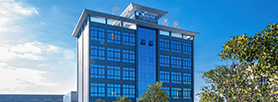ABOUT SUQING

Service
suqing group
Pollution and prevention methods and recovery methods of strong alkaline anion resin caused by organic matter
1、 Causes of Organic Matter Pollution on Strong Alkali Anion Resin
The contamination of strong alkaline resins by organic matter in raw water is the most common phenomenon. Its intuitive manifestation is that the washing time gradually extends, and even a few hours cannot complete the washing step. Due to the extension of washing time, the production water volume is relatively reduced, and it brings a lot of trouble and uncertainty to the operation.
1. There are only two possible reasons for the long washing time of the anion bed:
1.1. The effluent quality of the cation bed is poor, with a large amount of Na+leakage, resulting in a high pH value and conductivity of the anion bed, and an extended washing time. If the detection of Na+in the cation bed is normal, the impact of the effluent quality of the cation bed on the washing time of the anion bed can be ruled out.
1.2. It is the pollution of COD (organic matter) in the raw water on the anion resin that prolongs the washing time. The principle is that the organic matter in raw water (especially surface water or lake water) contains RCOOH (carboxylic acid group), which is a weak acid group. Because cation resins do not have the ability to remove COD (some sources suggest that cation resins can remove around 5% of organic matter in water), only anion resins (especially strong alkaline anion resins) can adsorb these COD. Although most of the COD can be resolved during each regeneration, a small amount of COD remains in the resin, accumulating over time, resulting in a certain amount of organic matter adsorbed by the resin, The phenomenon of prolonged washing time occurs. The mechanism is:
After the resin fails, when the resin is regenerated with alkaline solution, the following reactions will occur in the RCOOH of organic matter:
RCOOH+NaOH→RCOONa+H2O
The RCOOH in COD becomes RCOONa (sodium carboxylate), and these RCOONa adsorbed by the resin undergo hydrolysis reactions during displacement and washing after regeneration:
RCOONa+H2O→RCOOH+NaOH
These adsorbed RCOOHs, after regeneration, become RCOONa. During replacement washing, RCOONa will hydrolyze and release NaOH, resulting in NaOH aging and uncleanness, high pH, and high conductivity during washing. Only when RCOONa is completely hydrolyzed into RCOOH and NaOH is not hydrolyzed will the conductivity decrease and the washing process end.
Therefore, from the above description, it can be seen that the length of washing time completely depends on the degree of COD pollution of the anion resin. Only by controlling COD pollution of the resin from the source can the problem of strong alkali resin being fundamentally solved. The removal of COD is mainly achieved through coagulation, clarification, and adsorption of activated carbon. According to the requirements of the Electric Power Design Specification, the indicator is: COD ≤ 2mg/l.
2、 The methods to prevent resin from being contaminated by organic matter mainly include the following aspects:
1. Select good water sources, strengthen the coagulation and clarification pre-treatment of raw water, and strictly control the COD of raw water within the standard requirements;
2. Adding an activated carbon filter before inbreeding can greatly reduce the pollution of organic matter on the resin;
3. Adding resin organic cleaning agent before the strong anion resin can also effectively protect the strong alkali resin and reduce pollution.
3、 Resuscitation method of organic matter contaminated anion resin
For anion resins contaminated with organic matter, the dynamic cycling immersion effect is better when using a 2% NaOH+8% NaCl mixture that is 2-3 times the resin volume. If the temperature is heated to 35-40 ℃, the effect is better. This is a practical and non harmful treatment method for the resin. As for other recovery methods such as organic solvents, surfactants, oxidants, ultrasound, etc., they not only cause certain damage to the resin, but are also difficult for users to implement. Therefore, it is not recommended to use.
▶ Add : No.89 Changqing Road, Hetang, Changjing Town, Jiangyin, Jiangsu
▶ Postal code: 214419
▶ Sales Department: +86-510-86337020, 86339050, 86331801
▶ Fax: +86-510-86331113, 86332672
▶ Technology Research Institute: +86-510-86339015
▶ Engineering Technology Department: +86-510-86339188
▶ International Trade: +86-510-86339038, 86336700, 86336655
▶ Complaints: suqingzyg@163.com, +86-510-86339015
▶ E-mail: dominic@suqing.com, sqsales@suqing.com



Mobile version
Copyright(C)2023, Suqing Group All Rights Reserved. Supported by ChinaChemNet ChemNet Toocle Copyright Notice 备案序号:苏ICP备05012645号